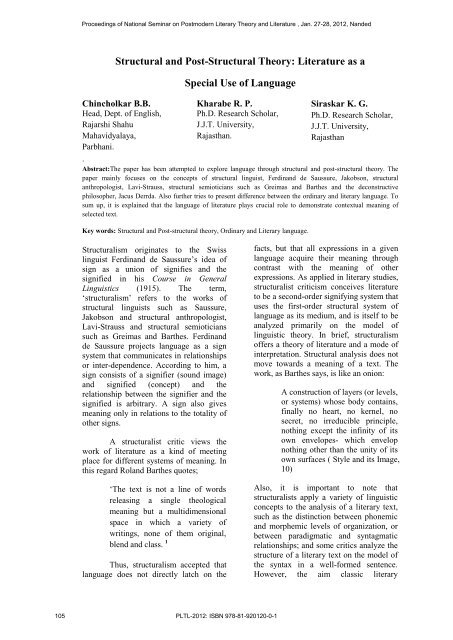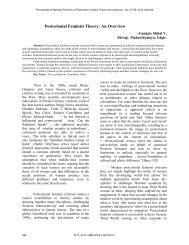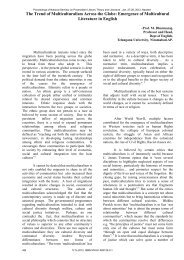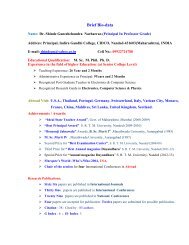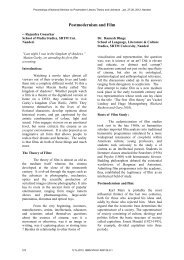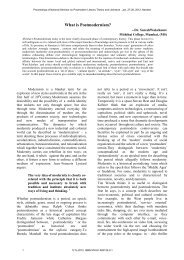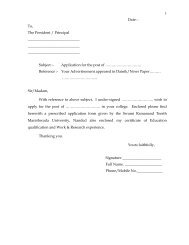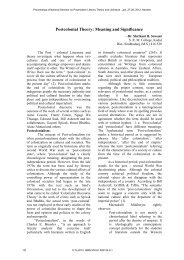Post-Structuralism: An Indian Preview - Igcollege.org
Post-Structuralism: An Indian Preview - Igcollege.org
Post-Structuralism: An Indian Preview - Igcollege.org
You also want an ePaper? Increase the reach of your titles
YUMPU automatically turns print PDFs into web optimized ePapers that Google loves.
Proceedings of National Seminar on <strong>Post</strong>modern Literary Theory and Literature , Jan. 27-28, 2012, Nanded<br />
Structural and <strong>Post</strong>-Structural Theory: Literature as a<br />
Chincholkar B.B.<br />
Head, Dept. of English,<br />
Rajarshi Shahu<br />
Mahavidyalaya,<br />
Parbhani.<br />
Special Use of Language<br />
Kharabe R. P.<br />
Ph.D. Research Scholar,<br />
J.J.T. University,<br />
Rajasthan.<br />
Siraskar K. G.<br />
Ph.D. Research Scholar,<br />
J.J.T. University,<br />
Rajasthan<br />
.<br />
Abstract:The paper has been attempted to explore language through structural and post-structural theory. The<br />
paper mainly focuses on the concepts of structural linguist, Ferdinand de Saussure, Jakobson, structural<br />
anthropologist, Lavi-Strauss, structural semioticians such as Greimas and Barthes and the deconstructive<br />
philosopher, Jacus Derrda. Also further tries to present difference between the ordinary and literary language. To<br />
sum up, it is explained that the language of literature plays crucial role to demonstrate contextual meaning of<br />
selected text.<br />
Key words: Structural and <strong>Post</strong>-structural theory, Ordinary and Literary language.<br />
<strong>Structuralism</strong> originates to the Swiss<br />
linguist Ferdinand de Saussure’s idea of<br />
sign as a union of signifies and the<br />
signified in his Course in General<br />
Linguistics (1915). The term,<br />
‘structuralism’ refers to the works of<br />
structural linguists such as Saussure,<br />
Jakobson and structural anthropologist,<br />
Lavi-Strauss and structural semioticians<br />
such as Greimas and Barthes. Ferdinand<br />
de Saussure projects language as a sign<br />
system that communicates in relationships<br />
or inter-dependence. According to him, a<br />
sign consists of a signifier (sound image)<br />
and signified (concept) and the<br />
relationship between the signifier and the<br />
signified is arbitrary. A sign also gives<br />
meaning only in relations to the totality of<br />
other signs.<br />
A structuralist critic views the<br />
work of literature as a kind of meeting<br />
place for different systems of meaning. In<br />
this regard Roland Barthes quotes;<br />
‘The text is not a line of words<br />
releasing a single theological<br />
meaning but a multidimensional<br />
space in which a variety of<br />
writings, none of them original,<br />
blend and class. 1<br />
Thus, structuralism accepted that<br />
language does not directly latch on the<br />
facts, but that all expressions in a given<br />
language acquire their meaning through<br />
contrast with the meaning of other<br />
expressions. As applied in literary studies,<br />
structuralist criticism conceives literature<br />
to be a second-order signifying system that<br />
uses the first-order structural system of<br />
language as its medium, and is itself to be<br />
analyzed primarily on the model of<br />
linguistic theory. In brief, structuralism<br />
offers a theory of literature and a mode of<br />
interpretation. Structural analysis does not<br />
move towards a meaning of a text. The<br />
work, as Barthes says, is like an onion:<br />
A construction of layers (or levels,<br />
or systems) whose body contains,<br />
finally no heart, no kernel, no<br />
secret, no irreducible principle,<br />
nothing except the infinity of its<br />
own envelopes- which envelop<br />
nothing other than the unity of its<br />
own surfaces ( Style and its Image,<br />
10)<br />
Also, it is important to note that<br />
structuralists apply a variety of linguistic<br />
concepts to the analysis of a literary text,<br />
such as the distinction between phonemic<br />
and morphemic levels of <strong>org</strong>anization, or<br />
between paradigmatic and syntagmatic<br />
relationships; and some critics analyze the<br />
structure of a literary text on the model of<br />
the syntax in a well-formed sentence.<br />
However, the aim classic literary<br />
105 PLTL-2012: ISBN 978-81-920120-0-1


